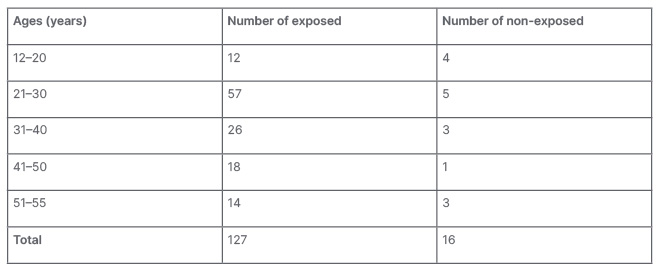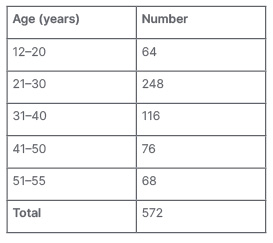Abstract
Introduction: Chronic kidney diseases (CKD) are very prevalent in Central America, particularly in El Salvador. Mesoamerican nephropathy (MN) is a CKD diagnosis that mostly affects male agricultural labourers; its aetiology is debatable. Prolonged contact with plague control pesticides is among the possible causes. To determine if there is any association between farming and long-term exposure to such chemical substances and MN in male agricultural labourers, a case control study was performed.
Methods: From January 2020–December 2021, the authors gathered a group of 143 male patients with CKD who met the MN criteria, as well as 572 male matched controls with no kidney disease. All were asked about any long-term exposure to agrochemical pesticides, and the odds ratio was calculated.
Results: A total of 715 individuals were included. There were 127 cases of MN in individuals who were exposed to agrochemicals and 16 cases in the non-exposed patients. Among the controls, the authors found that 348 had been exposed, while 224 had not. Exposure to pesticides was 5.2 times more likely to be associated with MN compared with individuals with no kidney disease.
Conclusion: MN could be a multifactorial disease, where heat stress and dehydration combine with direct long-term exposure to pesticides, causing damage to kidneys’ tubular network and leading to CKD. Further research is needed.
Key Points
1. Mesoamerican nephropathy (MN) is very prevalent among farmers in El Salvador, with approximately 50% of farmers having MN. Because of limited resources, it is almost 100% lethal in the short-term. Long-term exposure to agrochemicals, heat stress, and chronic dehydration are suspected to be associated factors.
2. In a group of 715 males (143 cases and 572 matched controls), work-related daily exposure to pesticides was 5.2-times more likely to be associated with MN compared with individuals with no kidney disease.
3. There are places at different latitudes in Latin America where MN has not been observed, despite documented poor handling of pesticides by farmers. Therefore, the authors speculate that it is a multifactorial disorder, where heat stress and protracted daily dehydration, combined with direct long-term exposure to pesticides, can damage the kidneys and lead to MN.
INTRODUCTION
Chronic kidney diseases (CKD) are very prevalent in Central America,1-6 particularly in El Salvador. Mesoamerican nephropathy (MN) is a CKD diagnosis that almost exclusively affects young male agricultural labourers.7 It was first reported over 20 years ago,8 and its aetiology has been a matter of debate since. Although other renal diseases with similar features have been described elsewhere,9,10 it is not clear yet whether they are part of a single entity. Long-term exposure to plague control pesticides is among the potential causes of MN.10,11
Pesticides are heavily applied in Central America, and high volumes of hazardous compounds are used. Researchers have estimated that approximately 400,000 poisonings occur per year (1.9% of population), where 76% are work-related. Reportedly, the region has brought in about 33 thousand tons of active ingredients per year between 2000–2004.12 Out of 41 pesticides included in the Stockholm Convention on Persistent Organic Pollutants treaty, the Rotterdam Convention on Prior Informed Consent, the Montreal Protocol on Substances that Deplete the Ozone Layer, the Pesticide Action Network (PAN) Dirty Dozen, and the Central American Dirty Dozen, 16 (17% total volume) were imported.13
Local studies have found that almost all farmers never use any kind of protection to avoid direct contact with such chemicals when spraying them on corn, beans, and sugar cane crops. They do not wear proper protective clothing, such as eyeglasses and gloves, and there is no adequate handling of hardware while spraying.14 Due to the lack of running water in most rural homes, very few agricultural labourers wash their hands or shower after a day’s work.
Cross-sectional investigations have calculated an average 51.9% CKD prevalence in a sample of 976 males and 1,412 females.15 Interestingly, in a follow-up analysis of this sample, 215 were involved in agricultural jobs, and 94 were diagnosed as having CKD with non-traditional causes, with an estimated prevalence of 43%.16 In the original study of 202 patients, there were 118 (58%) males with non-traditional CKD.7 A 2015 survey of 4,817 people (3,111 females and 1,706 males) found that among 877 farmers, non-traditional CKD prevalence was 2.5 times higher (7.5% versus 3.0%) compared with individuals in other occupations.17
The authors performed this case control study to find out if there is any association between farming and long-term exposure to plague control chemical substances and MN in male agricultural labourers.
METHODS
The investigation was developed in a referral hospital in San Salvador, El Salvador. From January 2020–December 2021, the authors gathered MN cases among patients with CKD, who had been admitted for dialysis, while controls were taken from males who had been admitted for surgery and outpatients sent for pre-operative evaluation.
Cases were defined accordingly to the following profile: males aged between 12–55; patients who did not have diabetes; no history of obstructive urological disease of any kind; no chronic intake of over the counter non-steroidal anti-inflammatory analgesics, meaning less than 6 consecutive days18 and at most 4 times in any year; no history of previously known systemic arterial hypertension before the diagnosis of renal disease; and no history of autoimmune disease.
Kidney ultrasound imaging was not necessarily performed or required.
On the other hand, the control group was built up of patients who shared the same features, except renal pathology. They were also asked about exposure to pesticides and were matched by age within a 2-year range, up or down. Four controls for each case were collected.
Exposure was defined as having worked in agricultural labour and having mixed and sprayed chemical pesticides on crops for more than 2 years in a row, while carrying a backpack pump filled with agrochemical compounds and wearing no protection at all. As previously explained, this is considered ‘normal’ farming practice in El Salvador. As a result of poverty, most rural homes do not have running water and usually they do not shower after a day’s work.
Due to the study’s characteristics, all patients’ rights were fully granted, and Institutional Review Board permission was waived.
RESULTS
A total of 715 individuals were included (143 cases and 572 matched controls). Exposure to pesticides was 5.2-times more likely to be associated to MN compared with individuals with no kidney disease (Table 1). Every farmer reported exposure to agrochemical compounds. They treated their crops by applying pesticides while wearing a backpack pump without any kind of protection. There were 127 exposed cases: 58 worked on sugar cane farms near in coastal areas, 37 worked on corn farms, and 32 grew bean crops. About half of the latter two crops were grown near the to the coast, with the remaining half growing crops in higher parts of the country. Their age distribution is shown in Table 2.

Table 1: Cases and controls.
95% confidence interval: 2.95–8.82; p<0.0001; z=5.851; odds ratio=(a/b)/(c/d)=127×224/16×348=28,448/5,568=5.10.

Table 2: Cases and age distribution of agricultural workers.
While some of the agricultural labourers had had 1–9 years of formal schooling, 22 were completely illiterate. None of the 16 patients with CDK who had not been exposed had ever worked in farming. They were taxi drivers, construction workers, street vendors, tailors, carpenters, and shoemakers, as well as one student. There were 400 control inpatients taken from surgical wards and 172 outpatients from surgical offices. All had a normal creatinine (<1.3 mg/dL) blood test. Out of the 572 individuals with no kidney disease, the authors found that 224 (39.1%) had never worked in any agriculture-related job. Again, their occupations were taxi drivers, bus drivers, construction workers, street vendors, mechanics, security guards, bartenders, accountants, welders, electricians, musicians, cooks, and gardeners, including one undertaker. Their age distribution is shown in Table 3.

Table 3: Age distribution of the control group.
DISCUSSION
Over the last 50 years, CKD incidence has increased worldwide,19,20 and in Latin America it went up from 33.3 patients per million people in 1993 to 167 patients per million people in 2005.21 The most frequently identified risk factors are diabetes and arterial hypertension.22 Non-traditional risk factor-associated nephropathy with agricultural labours is almost absent in North and South America.
Epidemiological evidence suggests an association between farming and CKD.15,23-25 By doing a spatial regression analysis across Central America, researchers have found more support for heat stress as a risk factor than agricultural pesticide use.26 Nevertheless, it is noteworthy that there are places where MN is almost unknown, no matter the altitude that crops are grown at,27 and despite farmers who are handling agrochemicals inappropriately and without protection. The only noticeable difference that has been reported is that 76% of farmers do shower and change clothes after applying pesticides.28 However, a cross sectional study performed in Nicaragua found the presence of CKD biomarkers among non-agricultural labourers (e.g., miners, construction, factory, and port workers), no specific profile tools to look for MN were implemented.29
Elsewhere in the Americas, neither farming nor any other occupation has been associated with CKD, except in Central America. However, poor handling of pesticides by agricultural labourers is also common practice in places like Mexico,30 Cuba,28 Peru,31 and Argentina.32
Central American agriculture workers’ living standards are identical to those of other working-class individuals, with similar incomes, housing, clothing, food, habits, education, and medical conditions. Diabetes and arterial hypertension, for example, are equally prevalent for everybody, regardless of their jobs. Nevertheless, MN is diagnosed almost exclusively in individuals involved in farming activities. The only identifiable toxic substances in this profession are the chemical compounds used to spray on crops.
Evidence concerning CKD being related to heat stress exposure by itself seems inconsistent.24,33-35 Repeated daily dehydration has been documented in farm labourers,35 and in mice it promotes tubular injury.36 However, it is not known whether these changes happen in humans. On the other hand, cross sectional analyses in farming communities have found that, when it comes to contact with agrochemicals, CKD prevalence is twice as high in males than it is in females (66.5% versus 33.1%).15 Meanwhile, CKD prevalence is almost the same in children of rural communities, for young males and young females.37
Because about 20% of patients with long-term hypertension silently develop renal disease,38,39 there is a chance that some subjects with MN profile had CKD related to systemic arterial hypertension. Furthermore, there could have been a few individuals with other types of non-traditional CKD diagnoses, among those who had no histological and kidney ultrasound tests.
CONCLUSION
Ultimately, this study leaves more questions than answers. The authors cannot explain why MN is absent in other Latin American regions, in spite of farmers not handling pesticides correctly either. For the time being, the authors speculate that MN is probably a multifactorial disease, where heat stress and dehydration combine with direct long-term exposure to pesticides, bringing about damage to kidneys’ tubular network and leading to CKD. Further research into this matter is required.






